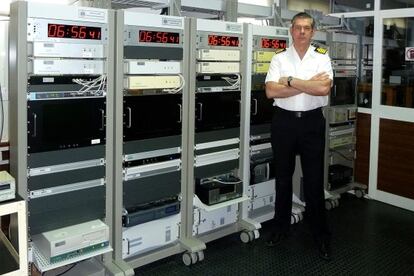The man who just added a second to Spaniards’ lives
Navy officer Francisco Javier Galindo is in charge of adjusting the universal time standard

The Spanish navy officer Francisco Javier Galindo could not imagine what the future held when, back in 1990, he stepped off the Numancia at a Danish port. The guided-missile frigate, on its way to Iceland for maneuvers, was ordered back to participate in the first Iraq war against the regime of Saddam Hussein.
Galindo, born in the Spanish exclave city of Melilla in 1963, went back to Spain for a training course that saved him from seeing combat. These days, he is a naval captain (a rank equivalent to army colonel), a physicist specializing in electronics, and head of the Time Section of the navy’s Royal Institute and Observatory in San Fernando (Cádiz). Naval warfare has become a thing of the past. “I see a picture of a ship now and I get seasick,” he jokes.
We work with time, so we cannot afford the luxury of running into a problem”
Navy Captain Francisco Javier Galindo
This man is in charge of adding an extra second to Spain’s official time at 2am on July 1, in order to synchronize the country’s clocks and watches with the Sun.
His laboratory, which is the headquarters for Spain’s official legal time, has 30 computer servers that provide the official time to clients such as telecoms operators and the Spanish government. Any one of these servers receives up to four million requests a day.
“What, then, is time? If nobody asks me, I know; if I have to explain it to, I don’t,” jokes Galindo, quoting the fourth-century philosopher Augustine of Hippo.
In 1884, he notes, when the railroad and the telegraph forced the world to synchronize their watches in order to share trains and communications, the wealthiest nations got together in Washington DC at the International Meridian Conference and decided to adopt the Greenwich meridian as a world standard of time measurement.

The time depended on the Sun going over this English location, and thus on the rotation of the Earth around its own axis, and it was called Universal Time (UT), or Greenwich Mean Time (GMT).
And so it was for decades, until scientists realized that the Earth’s rotation was not a very good system for accurate timekeeping.
“The Earth actually has a tendency to slow down, due mostly to the tides, like a top losing its spin,” explains Galindo.
A mean solar day does not really last 24 hours made up of 60 minutes made up of 60 seconds (86,400 seconds in total), but a couple of thousandths of a second more on average.
Atomic clocks put an end to this botched job. A caesium-133 atom produces 9,192,631,770 oscillations per second when it is at a temperature of precisely -273ºC (or 0 degrees in the Kelvin scale). So in 1967 the second stopped being defined as a mean solar day divided by 86,400 and instead came to be described by the International Committee for Weights and Measures as “the duration of 9,192,631,770 periods of the radiation corresponding to the transition between the two hyperfine levels of the ground state of the caesium-133 atom.”
The last time a leap second was introduced, the computer system of Australian airline Qantas was down for hours
A new standard was born: International Atomic Time, or TAI to use its French acronym.
At this point in his explanation, the captain knows that he is entering slippery terrain.
“Traditionally, we had a clock associated with the Earth, and which was not very good, but good enough for everyday purposes,” he says. “Now our clocks are based on physical processes and they are very precise.”
Yet the world cannot entirely do without the old GMT standard, note Galindo and his colleague Teodoro López in an article published in Revista General de Marina, a specialized publication put out by the navy. Sailors who still use astronomical navigation need it to find their way across the oceans.
To resolve this conundrum, experts came up with Coordinated Universal Time (UTC), the global standard of reference these days. It is counted in atomic seconds and periodically corrected so it is never off from GMT by more than 0.9 seconds.

This adjustment is performed by introducing an extra second, called a leap second, whenever necessary. The individual who decides when a leap second is required is a French astronomer named Daniel Gambis, director of the International Earth Rotation and Reference Systems Service at the Paris Observatory.
On January 5 of this year, Gambis issued a worldwide release “to authorities responsible for the measurement and distribution of time.” In Spain, the message was received by Captain Galindo.
The message said the following:
“A positive leap second will be introduced at the end of June 2015. The sequence of dates of the UTC second markers will be:
2015 June 30, 23h 59m 59s
2015 June 30, 23h 59m 60s
2015 July 1, 0h 0m 0s”
Because the change will be introduced at UTC time (UTC + 2 in peninsular Spain), the extra second will be added at 2am in the early hours of Wednesday.
This will be the 26th time that a leap second has been added since the practice began in 1972.
“And it could be the last,” admits Gambis in a telephone conversation from the Paris Observatory.
The International Telecommunications Union (UIT), the United Nations body in charge of the issue, attempted to eliminate leap seconds in 2012, but finally postponed the decision.
But there are “high probabilities” that an upcoming gathering of world authorities in Geneva in November “will decide to definitively eliminate the current practice of leap seconds,” according to Galindo and López.
Time for a new standard?
A majority of countries, with the United States in the lead, support a continuous time scale that does not require constant adjustments. The biggest critics of the leap second system warn about potential problems with some internet browsers, flight delays due to computer glitches and the collapse of Unix, an operating system implemented by IBM, Hewlett-Packard, Apple and others.
Gambis himself recalls how the last time a leap second was introduced on June 30, 2012, “the computer system for the Australian airline Qantas was down for hours.”
And certain software’s trouble dealing with the extra time also brought down some of the world’s most popular websites, such as the news aggregator Reddit or the professional network Linkedin.
But the controversial leap seconds have one stalwart supporter: Great Britain. As Galindo explains, London’s legal time reference is not UTC, the standard for most nations, but the obsolete (but British-made) GMT. If these artificial seconds were eliminated, UTC would drift increasingly away from the time based on Earth’s rotation. By the year 2100, there would be a three-minute difference. Britain would either have to give up on Greenwich, or dig in its heels and accept a three-minute difference with the rest of the world.
Whether this is the last leap second in history or not, Captain Galindo is prepared to insert it tonight. The process is completely automated and rehearsals have taken place for the last month at the navy’s Royal Institute and Observatory in San Fernando, which is Spain’s oldest astronomy observatory.
Galindo’s machines have been sending alerts to their clients since June 1, making sure they are ready to deal with the extra second.
“We work with time, so we cannot afford the luxury of running into a problem,” he says.
But Galindo is so certain that everything will go smoothly that at 2am he is planning to be in bed. There will be nobody at the lab. “It’s not necessary.”
Tu suscripción se está usando en otro dispositivo
¿Quieres añadir otro usuario a tu suscripción?
Si continúas leyendo en este dispositivo, no se podrá leer en el otro.
FlechaTu suscripción se está usando en otro dispositivo y solo puedes acceder a EL PAÍS desde un dispositivo a la vez.
Si quieres compartir tu cuenta, cambia tu suscripción a la modalidad Premium, así podrás añadir otro usuario. Cada uno accederá con su propia cuenta de email, lo que os permitirá personalizar vuestra experiencia en EL PAÍS.
¿Tienes una suscripción de empresa? Accede aquí para contratar más cuentas.
En el caso de no saber quién está usando tu cuenta, te recomendamos cambiar tu contraseña aquí.
Si decides continuar compartiendo tu cuenta, este mensaje se mostrará en tu dispositivo y en el de la otra persona que está usando tu cuenta de forma indefinida, afectando a tu experiencia de lectura. Puedes consultar aquí los términos y condiciones de la suscripción digital.
Últimas noticias
Maduro pleads not guilty before the federal court in New York: ‘I am still the president of Venezuela’
A new test can detect Alzheimer’s from a finger prick
UN team enters Sudanese city of El Fasher after paramilitary massacre: ‘It’s like a ghost town’
A recipe for resistance: Indigenous peoples politicize their struggles from the kitchen
Most viewed
- Gilles Lipovetsky: ‘If you want to live better and fall in love, take Prozac, don’t look to philosophy’
- Alain Aspect, Nobel laureate in physics: ‘Einstein was so smart that he would have had to recognize quantum entanglement’
- Alvin Hellerstein, a 92-year-old judge appointed by Bill Clinton, to preside over Maduro’s trial in New York
- Maduro’s downfall puts China’s relationship with Venezuela to the test
- Why oil has been at the center of Venezuela-US conflicts for decades









































